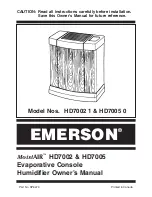
10
2.9 Using the Ethernet Feature (J3)
The dryer controller is equipped with an Ethernet port
located at J3 on the control board which allows the customer
to connect the dryer to a local area network. The customer
can then monitor the dryer status and performance via Web
Interface or ModbusTCP.
1. Web Interface
After assigning an IP address to the dryer the IP address
can be entered into the address bar of any web browser to
connect to the web interface.
The first page displayed is the home screen. Displayed on
this page are the dryers operating status, operating mode,
current dryer load, evaporator inlet temperature, evaporator
outlet temperature, discharge temperature, energy savings,
and any active alarms. The navigation bar at the top of this
page can be used to view event history, dryer scheduler,
and dryer settings.
Energy savings is shown as the estimated annual energy
savings based on the actual energy cost (entered on the
settings page) and the average dryer load over the last 30
days.
Figure 1: Home Screen
The event history page shows the last 64 timestamped
events that have occurred on the dryer. These events include
power failure/recovery, dryer mode changes, dryer status
changes, and alarms.
Figure 2: Event History
The dryer scheduler page allows the customer to view/edit
the daily start/stop times that will be used when operating
the dryer in scheduled mode.
Figure 3: Schedule
The dryer settings screen allows the customer to view/edit
various dryer set points and setup E-mail alerts that will send
an e-mail to up to 3 different e-mail addresses whenever an
alarm or warning occurs on the dryer.













































